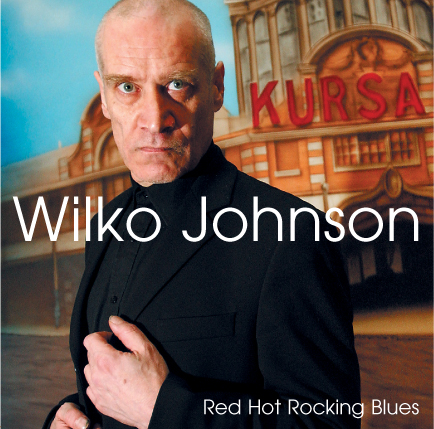 WILKO JOHNSON
WILKO JOHNSON
Founder guitarist and songwriter for the 70’s r&b band Dr. Feelgood, Wilko Johnson’s manic performances and choppy rhythm/lead style became their distinguishing trademark.
Four groundbreaking albums, Down By The Jetty, Malpractice, Stupidity (a UK no. 1 chart-topper) and Sneakin’ Suspicion, put Wilko and the Feelgoods firmly on the rock landscape from 1974 to 1977. In that era of turgid progressive and fey glam-rock, their high-energy dirty R&B and be-suited appearance was a mini-revolution, bringing rock’n’roll back to the roots and giving inspiration to both the UK and US fledgling punk scenes.
Splitting from the Feelgoods, Wilko formed the Solid Senders and signed to Virgin for an eponymous album. Then under his own name he released further albums, including Ice On The Motorway, Barbed Wire Blues and Going Back Home, and finding a live audience particularly in Europe and Japan for his frantic, exciting gigs.
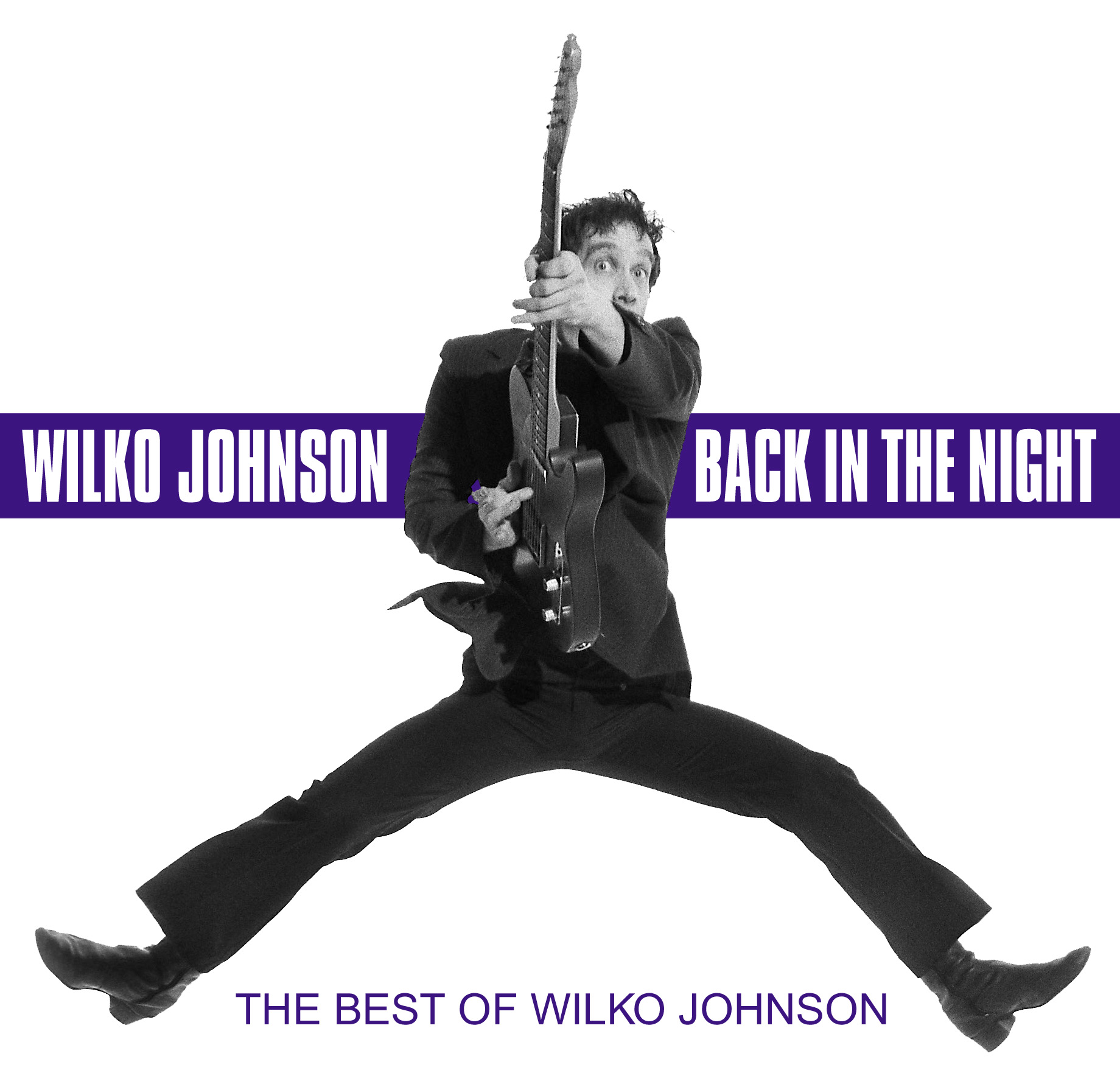 Teaming up with IAN DURY & THE BLOCKHEADS for their Laughter album led Wilko to regular guest appearances with them over the years, and the association brought a partnership with Norman Watt-Roy. The much-revered bassist (also known for his sessions with Frankie Goes To Hollywood and The Clash) has been Wilko’s foil for the past eighteen years, providing a solid foundation for Wilko to scatter his wild guitar tricks over. Completing the 3-piece is former Blockheads drummer Monti, recently replacing the long-serving Salvatore Ramundo.
Teaming up with IAN DURY & THE BLOCKHEADS for their Laughter album led Wilko to regular guest appearances with them over the years, and the association brought a partnership with Norman Watt-Roy. The much-revered bassist (also known for his sessions with Frankie Goes To Hollywood and The Clash) has been Wilko’s foil for the past eighteen years, providing a solid foundation for Wilko to scatter his wild guitar tricks over. Completing the 3-piece is former Blockheads drummer Monti, recently replacing the long-serving Salvatore Ramundo.
Back In The Night, a ‘best of’ Wilko Johnson retrospective from the past 22 years was released in 2002. Now ‘Red Hot Rocking Blues’, the first new studio album since 1998 is due, a collection of Wilko-ised covers of classics by people like Van Morrison, Bob Dylan, Ray Charles, Sonny Boy Williamson, Leadbelly, etc. A Dr. Feelgood live ’75 DVD plus CD is also released, on EMI.
Wilko's busy gig schedule regularly takes him around the UK, Ireland, Spain, Sweden, Finland and Japan. Touring constantly, he always turns in a crowd-pleasing show … so make sure you catch Wilko live!
(2005 biography.)
Click here for
www.johnnythunders.info
the Johnny Thunders timeline, 1971 - 1991
Johnny Thunders Livin in a Jungle - playlist
Sean Tyla’s Ducks Deluxe & Tyla Gang
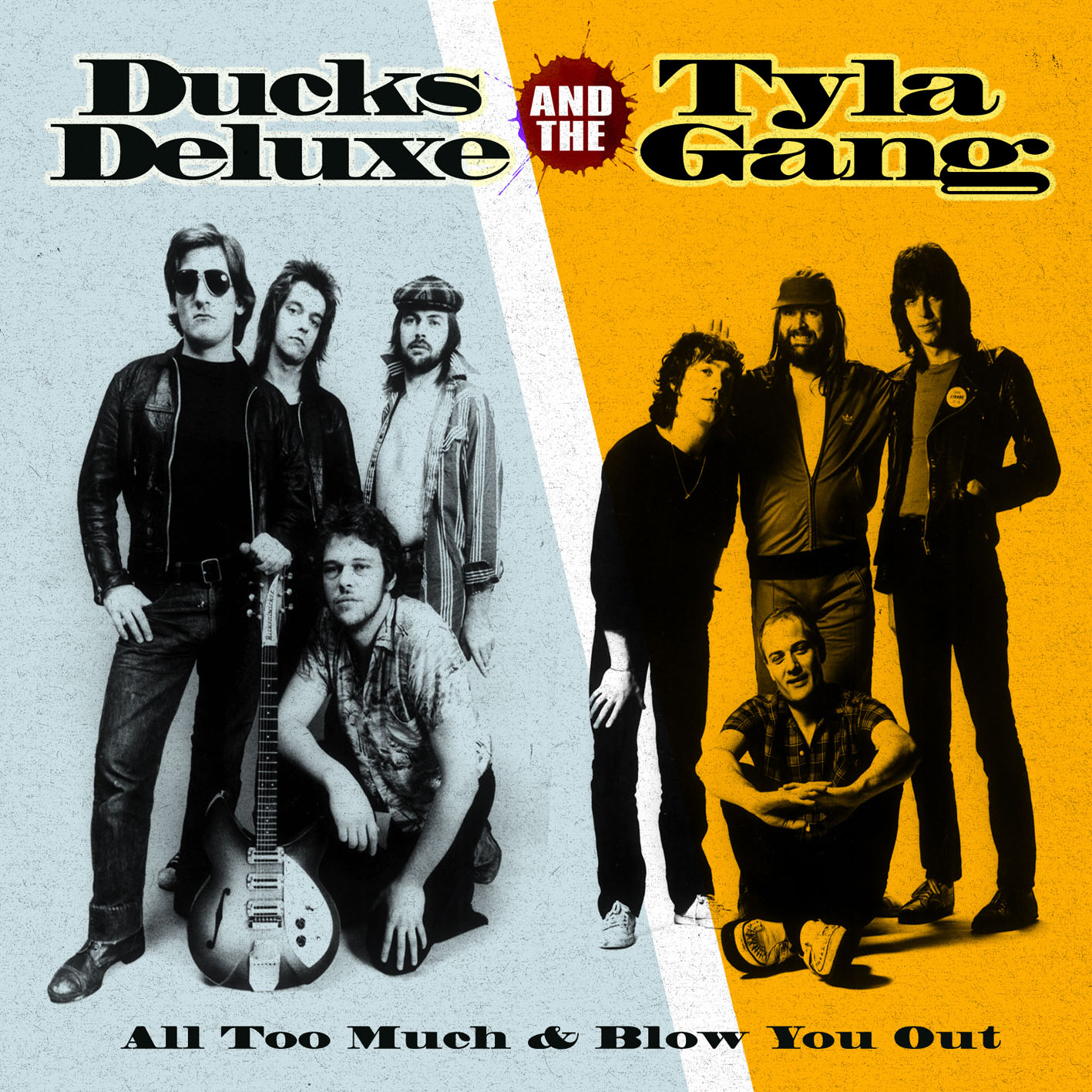
Learning your musical trade by touring with Geno Washington’s Ram Jam Band is one of the best soul/funk groundings one can ask for in the UK – the hard-working soul trooper, immortalised in song by Dexy’s Midnight Runners, was perhaps the nearest we had to the bands of the US ‘chitlin’ circuit’. After Sean Tyla having paid his dues with both Geno and Freddie ‘Fingers’ Lee, he formed Ducks Deluxe in 1972, with an initial line-up of Martin Belmont, Tim Roper and ex-Help Yourself Ken Whaley.
Ducks Deluxe, alongside their close associates Brinsley Schwartz, soon became part of a ‘back to basics’ underground musical community. Managers Dave Robinson and Dai Davies teamed up with Jake Riviera and other like-minded bookers and bands, and a small hive of activity built up around an office above the Hope & Anchor pub in Islington. Ducks Deluxe were a central part of this scene on the new circuit of venues open to good-time roots music.
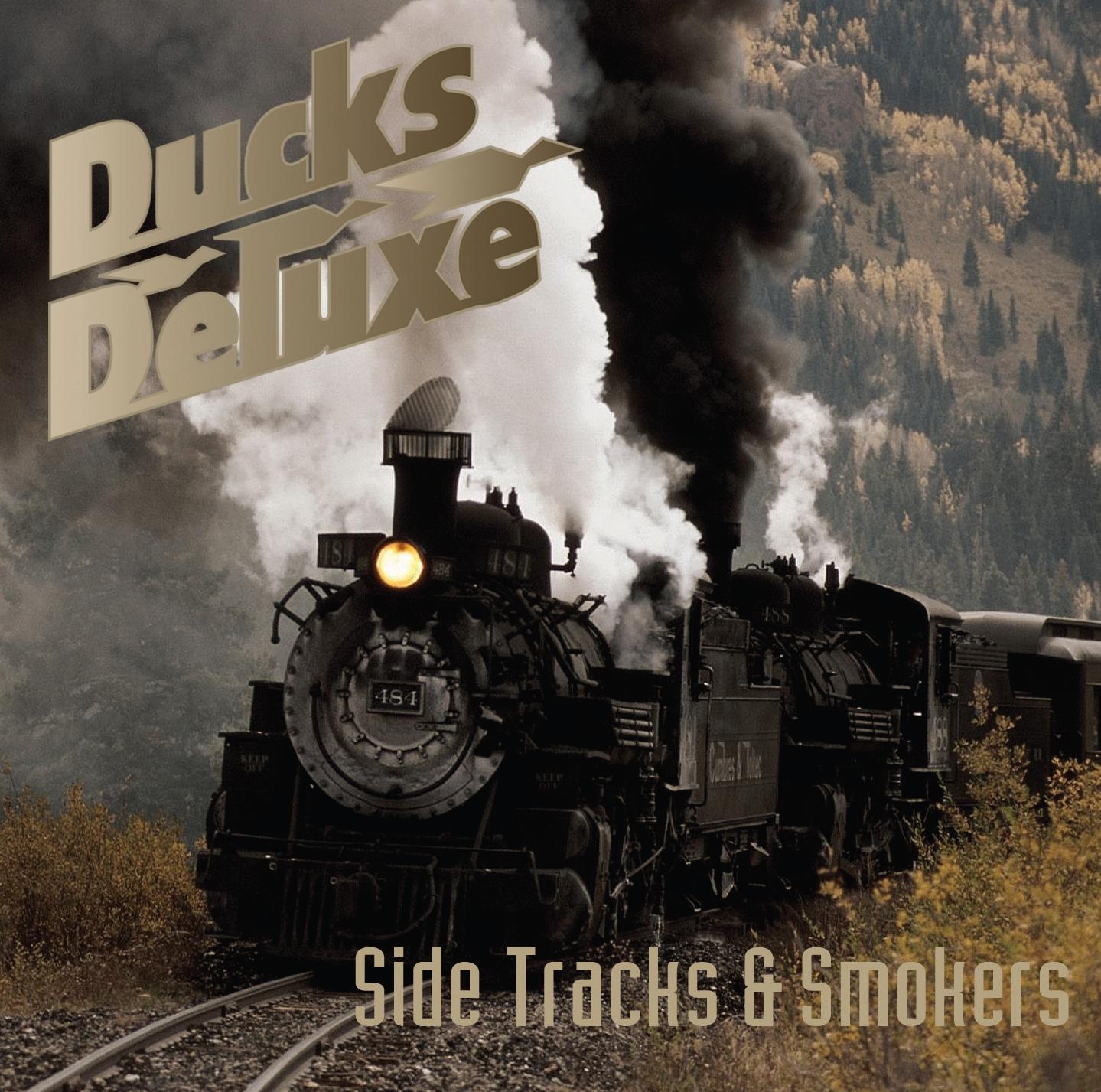 With a fluent amalgam of blues, soul and boogie laden with sex and drug references, they were swiftly welcomed by crowds also buzzing on new US bands such as Little Feat working with a similar template. Alongside originals were a handful of covers: it’s quite likely that Joe Strummer, then of the 101-ers, first heard Ducks’ version of the Bobby Fuller Four perennial ‘I Fought The Law’ before turning it into the Clash classic. Signing to RCA Records, they released the albums ‘Ducks Deluxe’ (1974) followed by ‘Taxi To The Terminal Zone’ (1975).
With a fluent amalgam of blues, soul and boogie laden with sex and drug references, they were swiftly welcomed by crowds also buzzing on new US bands such as Little Feat working with a similar template. Alongside originals were a handful of covers: it’s quite likely that Joe Strummer, then of the 101-ers, first heard Ducks’ version of the Bobby Fuller Four perennial ‘I Fought The Law’ before turning it into the Clash classic. Signing to RCA Records, they released the albums ‘Ducks Deluxe’ (1974) followed by ‘Taxi To The Terminal Zone’ (1975).
Ducks Deluxe attracted some fine musicians. Guitarist Martin Belmont, who earlier was a roadie for Brinsley Schwartz, was responsible for one of their best-known songs, ‘Something’s Going On’. He later went on to be a lynchpin of Graham Parker’s Rumour and Nick Lowe’s Cowboy Outfit, and recorded with Carlene Carter, John Hiatt and Billy Bragg, as well as a solo album, ‘Big Guitar’ on Demon Records. Bassist Nick Garvey, who also happened to be accomplished on piano, oboe and trumpet, went on with fellow Duck Andy McMasters to have big hits such as ‘Airport’ with The Motors. Brinsley Schwartz and Billy Rankin of Brinsley Schwartz also joined the band in their later period.
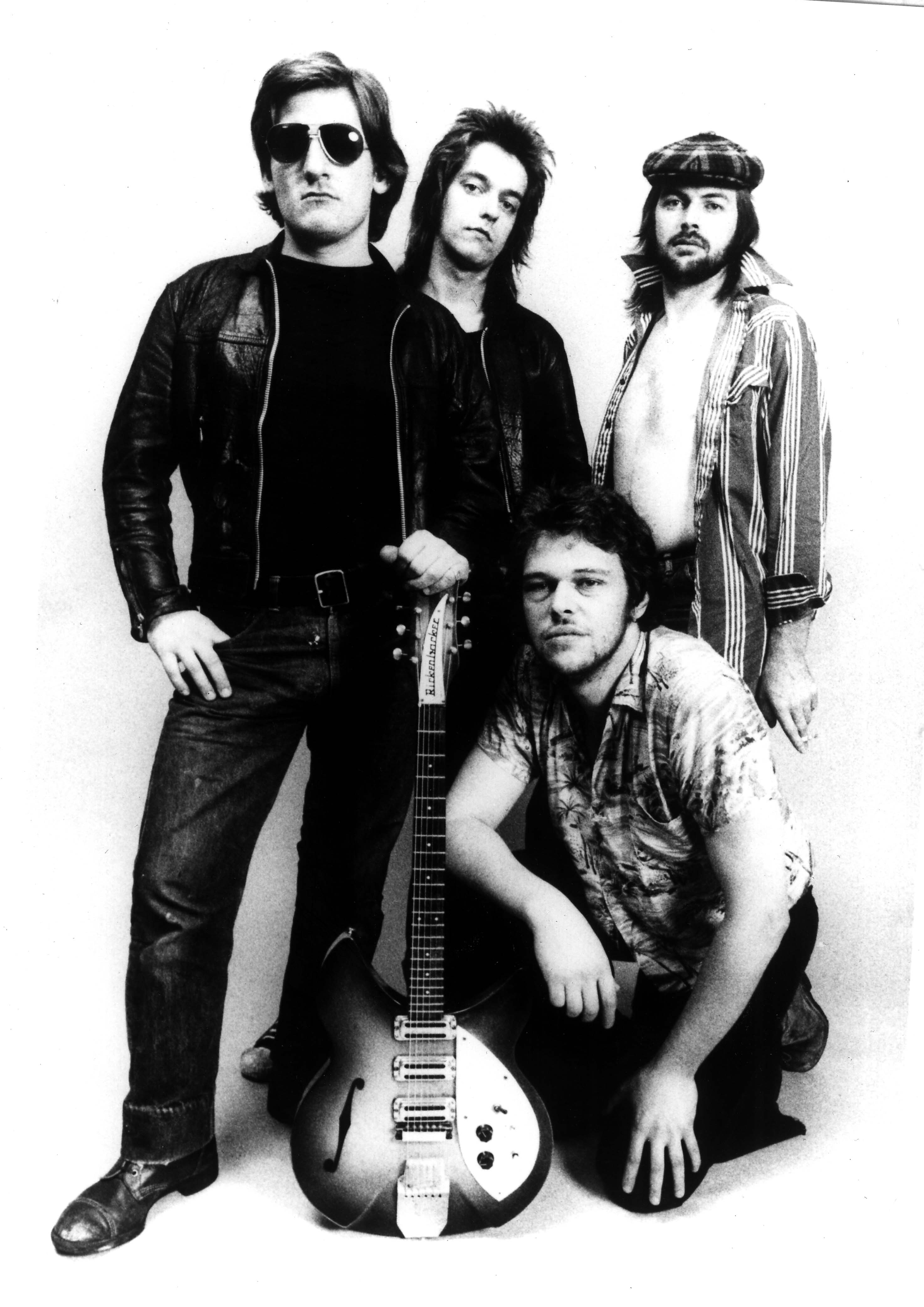 The band kept busy in the UK and also in Europe. When RCA let them go, pioneering French indie Skydog Records stepped in to issue an EP. Skydog were close to both the UK and US underground scenes, and by 1975 had already released records by the much-revered Flamin Groovies and Kim Fowley amongst others. Ducks Deluxe incidentally had another Groovies connection; Garvey had previously roadied for them.
The band kept busy in the UK and also in Europe. When RCA let them go, pioneering French indie Skydog Records stepped in to issue an EP. Skydog were close to both the UK and US underground scenes, and by 1975 had already released records by the much-revered Flamin Groovies and Kim Fowley amongst others. Ducks Deluxe incidentally had another Groovies connection; Garvey had previously roadied for them.
Eventually Ducks Deluxe called it a day with a memento farewell live album on Skydog’s Dutch sister-label Dynamite. The punk revolution was changing things, and it was Robinson & Riviera (with a little help from Dr. Feelgood) who were in the right position to capitalise with Stiff Records (with their first single, the Damned ‘New Rose’ being a Skydog co-release). Most of the bands Stiff signed were not punks but had their roots in the live so-called ‘pub-rock’ scene they’d earlier helped foster, but now under the more positive moniker of ‘new wave’. So in 1977 Sean Tyla easily found outlets for his next project, The Tyla Gang, both on the hippest new label around with the 7” single ‘Styrofoam’, and on the more established Skydog with a 7” release of ‘Suicide Jockey’.
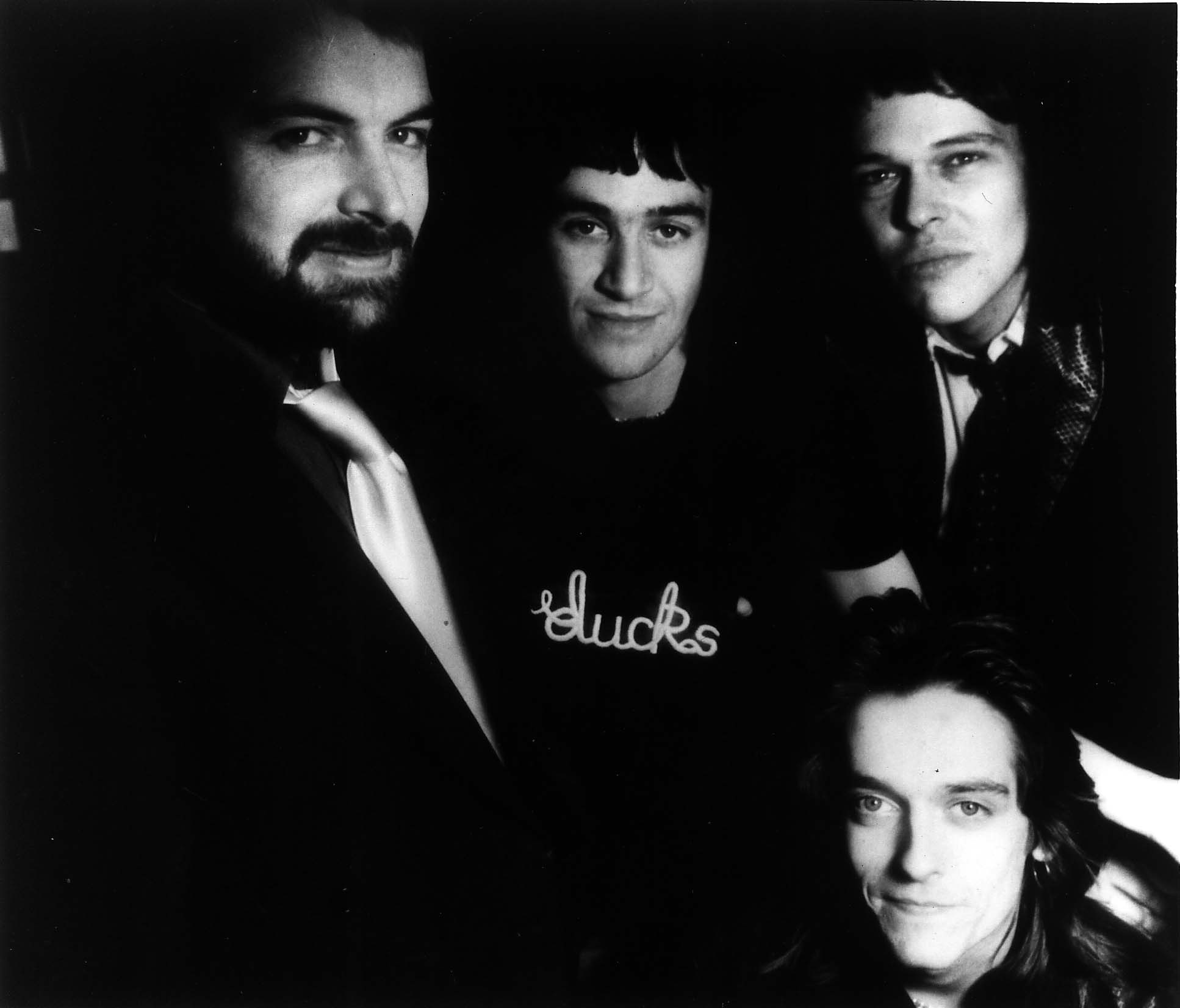 Then it was new US-based label Beserkely Records, home to The Modern Lovers, who signed Tyla Gang, producing two albums, ‘Yachtless’ (1977) and ‘Moonproof’ (1978). The Tyla Gang line-up featured Bruce Irvine on guitar and Mike Desmarai on drums; Peter O’Sullivan, Brian Turrington, and early Ducks member Ken Whaley variously handled the bass duties.
Then it was new US-based label Beserkely Records, home to The Modern Lovers, who signed Tyla Gang, producing two albums, ‘Yachtless’ (1977) and ‘Moonproof’ (1978). The Tyla Gang line-up featured Bruce Irvine on guitar and Mike Desmarai on drums; Peter O’Sullivan, Brian Turrington, and early Ducks member Ken Whaley variously handled the bass duties.
In 1978, Eddie & The Hot Rods manager, the late Ed Hollis, blagged some studio time at the Island Records studio, no doubt ostensibly to A&R and demo new upcoming talent. What he did was get all his mates in for sessions based around the Rods rhythm section of Steve Nicol and Andy Gray. Famed journalists Nick Kent and the late Giovanni Dadomo both laid down some tracks, the latter as his alter-ego Snivelling Shits. The Heartbreakers, The Lightning Raiders, a Rods roadie and Sean Tyla all also got sessions (available on Skydog as ‘Punks From The Underground’ SKY 62243-2). That Sean Tyla rarity is included here: ‘Speedball Boogie’ by The Speedballs.
After Tyla Gang had run its course, Sean Tyla released three albums under his own name: ‘Just Popped Out’ (Zilch, 1980), ‘Redneck In Babylon’ (Zilch, 1981), and ‘Rhythm Of The Swing’ (Instant 1983), plus an album he recorded in 1981 with Man’s Deke Leonard as The Force. Then for a while Tyla gave up the hard slog of the musician’s life and became a web-designer, but returned in the new millennium to the live scene with a new band. At the time of writing his website tells us there’s a brand new album being worked on right now and we can look forward to live gigs promised to coincide with it in 2007.
Update: lots of activity, new albums and tours for both Ducks Deluxe and The Tyla Gang, and Sean Tyla's autobiography published by Soundcheck Books.
Visit www.ducksdeluxe.net and www.tylagang.com
Notes to three deleted Jimi Hendrix albums, by John Perry
Just in case you’ve missed out on these albums from the much-abused PPX early years recordings...
The albums are now DELETED, because the Jimi Hendrix Estate’s solicitors provided us with evidence of a 1973 High Court Judgement, which deemed that most of these original 1965, 1966 & 1967 recordings made by PPX Enterprises should be - destroyed!
***If you're interested in the background of Curtis Knight and insight into his and Jimi Hendrix's relationship with entrepreneur Ed Chalpin (the man who first signed Jimi), there's a new book out by Kathy Knight-McConnell. Not only was she Curtis's partner for 16 years, she also worked for Ed Chalpin for long periods, and saw plenty of the legal machinations. 'Curtis Knight - Living in the Shadow of Jimi Hendrix' is best bought directly from Kathy's ebay shop.***
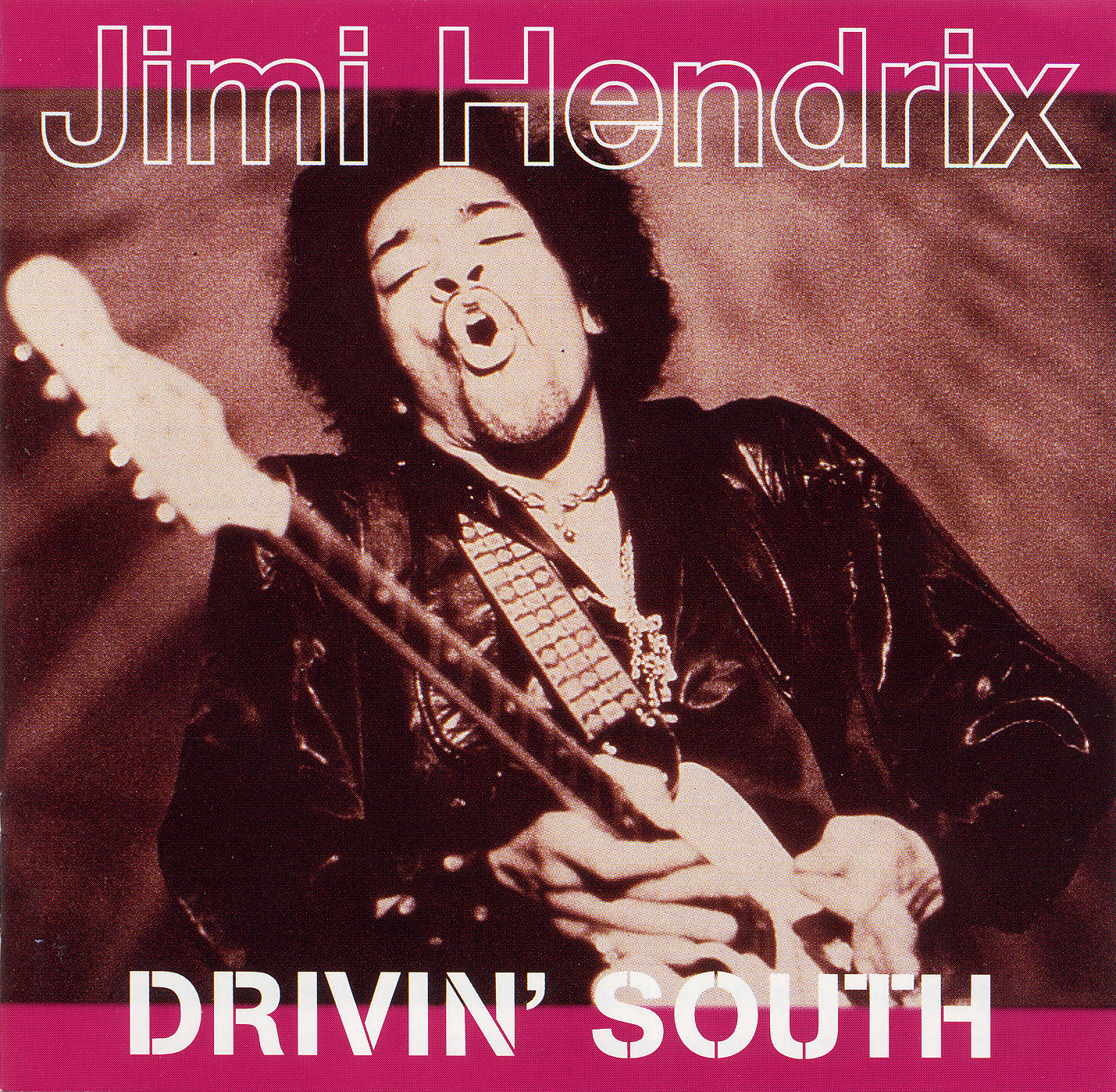 Jimi Hendrix 'Driving South'
Jimi Hendrix 'Driving South'
“Right now I’m scared. Like, soon I’ll be going into another bag, a new sound, a new record, a new experience. I dunno which way that’ll be, nothing will be intentional – it’ll just happen.”
That’s Jimi, speaking during the first flush of stardom, following his arrival in England and subsequent conquest of America at Monterey - but he might just as well have been talking at the time this live album was recorded. What you hear on the DRIVING SOUTH CD is the sound of the 23-year-old Jimmy James champing at the bit, just seven months before he signed with Chas Chandler, came to England and became JIMI HENDRIX.
Hendrix was the star turn with Curtis Knight’s band The Squires, a solid R&B outfit who worked the New York/New Jersey club circuit. On Boxing Day 1965 they played one of their regular venues, Georges Club 20 in Hackensack, New Jersey, with producer Ed Chalpin’s tape machine rolling. This is no chance audience-recording: it’s clear from Knight’s patter between songs that the band know they’re being recorded and Jimi plays - and sings - with all the intensity he can muster. And he’s having lotsa fun…
“Hey – I’m gonna tell how ya how big and bad I am” he announces over the intro to ‘I’m A Man’. With that dry, hip, understated sense of humour (too often overlooked when people recall Hendrix) he gets right inside the song’s fairly leaden lyric and subverts it, with great relish. Without ever dissing the Muddy Waters/Howlin Wolf tradition (which he loved) he makes it plain that he’s part of new generation of bluesmen, using self-mockery to distance himself from the standard macho blues-boasting of the lyric. Jimi was a great mimic: his imitations of Harlem drag queens and Little Richard’s tantrums, cracked up his friends. There’s just a hint of this audible in his articulation of the word ‘suspicious’, where his voice jumps up to near-falsetto.
The whole vocal approach is playful – especially noticeable next to the predictable, plodding vocals of Curtis Knight. This sort of playfulness only comes with being good. Very good. It’s that extra sense of time you notice in the best players, the best sportsmen – anyone who excels. They’ve got time to do the job and run a commentary alongside it. Rare gift.
If Hendrix retained any lingering doubts about his voice, he always had his guitar. The second he shuts his mouth and starts playing, double-time phrases flash across the stage like lightning. It’s easy to see why Chas Chandler refused to believe Hendrix wasn’t already signed to a major. “What’s the catch?” asked Chandler, “how could anyone this good not be under contract?”
* * *
For the main part, Jimi’s blues stylings owe most to Buddy Guy, though the surprise for anyone coming new to these recordings, is just how good he is by this stage. It’s easy to think that everything came together once Jimi got to England, and overlook what survives of his earlier work, but it just didn’t happen that way.
As the Arthur Lee/Rosa Lee Brooks single ‘My Diary’ shows, Hendrix already had the subtler voicings of the Curtis Mayfield/Bobby Womack guitar style down in 1964, and by late ’65 he was playing top class blues guitar like a motherfucker. There’s no other word. He’d spent time touring with the Isley Brothers and Little Richard’s band The Upsetters where his role was limited mostly to keeping time with the formation dance steps and sticking tight to the bass and drums as part of the rhythm section, so given a chance to cut loose on lead guitar, he goes for it - as on BB King’s ‘Sweet Little Angel’.
The extremely basic equipment Jimi’s using (a Fender Duo-Sonic guitar plugged straight into a Fender amp of some sort, possibly a Twin) provides plenty of volume, but it’s a sharp, clean volume, ideal for the blues, but entirely different from the warmth and sustain of the Marshall amps he discovered in England. His Fender amp won’t feedback. There’s a single note repeated several times, during Albert King’s ‘Travellin’ To California’ [0:55 and again at 1:25] that’s tantalisingly close to feeding - it’s right on the edge but it just won’t catch. If Jimi had grounded the guitar neck on the speaker-cab it would have certainly have gone, but full-blown feedback was yet to enter his vocabulary.
He’s playing without any effects (except possibly a dab of spring-reverb on the amp) and while the phrasing, and note selection are unmistakably Hendrix, his tone is just that bit closer to conventional American blues tone of the period. The inevitable influence of the Three Kings (BB, Albert and Freddy) is clear, alongside that of Buddy Guy, but there’s also a touch more Chuck Berry in evidence than you’d find among any of the purist, over-30’s bluesmen.
Jimi’s love of Elmore James is plain from his impassioned reading of ‘Bleeding Heart’ while the feel and timing of the Jimmy Reed standard ‘Baby What You Want Me to Do’ a/k/a ‘You Got Me Running’ could easily be the foundation of ‘Red House’. There are also preliminary whispers of what would become Hendrix’s ‘Talking Guitar’ trick – atonal licks mimicking the rhythms and natural cadences of speech - which he brought to perfection with the Experience (check the first ten seconds of ‘Still Raining, Still Dreaming’ from Electric Ladyland).
Even without feedback, fuzz-boxes, wah-wah or Roger Mayer’s Octavia, most of Jimi’s familiar technical devices are already in place. ‘Driving South’ features the one-handed trills he brought with him to England – a sound that Pete Townshend borrowed to great effect on The Who’s ‘I Can See For Miles’. You can tell Pete got the lick from Track Records label-mate Jimi, cos while the songs distinctive unison bends are all present on Pete’s 1966 demo, there’s no sign at all of the trill.
‘Killing Floor’ is interesting. It’s pitched halfway between an Albert King groove and the double-time arrangement Hendrix used to demolish Eric Clapton at the Central London Poly on the night of October 1st 1966.
The London rock scene Hendrix walked into in September 1966 was a bit like an Edwardian gentleman’s club. A small world with a rigid musical and social hierarchy, where everyone knew their place - and God was an Englishman, named Clapton. At the top table sat Cream, and no one ever sat in with them. Nobody was considered good enough.
Hendrix’s opening move was a straight, pre-war Kansas City cut. Jimi’s supporters – the loyal ladies club of Kathy Etchingham and Linda Keith plus friends, spread the word till the grapevine buzzed with rumours about the newcomer. Then Cream invited him to jam. So, on his eight day in the country, a complete unknown, Jimi sauntered out onto Cream’s stage and plugged into Clapton’s amp. Clapton stood to one side not even bothering to play. He folded his arms, lit a cigarette and looked on with detached amusement. About 30 seconds into ‘Killing Floor’ his jaw dropped open and the old order lay in ruins.
The afternoon before the coup, Jimi was gazing laconically from his manager’s office window when NME journalist Keith Altham asked him how he rated Clapton. “He is a kinda hero of mine” replied Hendrix, “except I don’t really have heroes. But I can’t wait to see if he’s as good as he really thinks I am.” Jimi went back to gazing slyly out the window…
* * *
I was interested to see what pitch the guitar was tuned to for this 1965 show. E is the norm for guitar, although after his first US tour in 1967 Jimi began tuning down half a step to E-flat (a tonality adopted by countless HM bands over the following decades). Slacker strings are less work to bend, and the lowered pitch made singing easier, placing less stress on a charming, idiosyncratic, but never especially powerful voice. "He wasn't a great singer but he had a great voice" as Steve Cropper's put it.
But if Hendrix started using E-flat circa '67, why look at a 1965 recording? Well, there's a second source of E-flat tuning. Soul bands, especially those with brass sections, traditionally played in the 'flat keys' of F, Bb, Eb, etc. to suit the horns. Great for the horn players: no problem either way for a competent keyboard player, but a nightmare for guitarists, since standard guitar tuning suits the sharp keys - G, D, A, and especially E. During his scuffling years, Jimmy may well have come across soul band guitarists tuned down to E-flat to fit in with the horns, but he's tuned to a standard E here.
Certainly Steve Cropper of Booker T and MG’s knew all about open- and alternate-tunings. He showed Vasspo’ tuning to Otis Redding, who took away the open-tuned guitar and returned 15 minutes later with ‘Dock of The Bay’ written. Cropper also knew about the soulful sound - ‘churchy’ is his word – obtained by dropping the bottom string of a standard-tuned guitar, down to D or even way down low to C. Pop Staples country.
Cropper and Hendrix met up and played together in Memphis, late ’64, during Jimi’s journeyman days. A tremendous amount of rubbish has been written about this meeting – stories of secret tapes etc. - so I asked Cropper to tell me what happened: -
Steve Cropper: "Well, Jimi came into Stax one day –- and somebody said ‘there’s this guy out the front wants to see you’. Well that used to happen once or twice a day on a regular basis, and they’d be told ‘well Steve’s real busy but if he has time he’ll try and see you’. I don’t think I was cutting anything that day but I was doing tape editing, a bunch of stuff and I completely forgot about it. Situation like that, without being rude, I’d always assume when it reached a certain point that a secretary would go out and say ‘Mr. Cropper’s not going to have time to see you’ and boom – there you are.
So I finally came out about 5 o’clock one of the girls was still there and she said ‘did you see that guy wanted to talk to you today?’ And I said ‘no – why, he’s still hanging around?’ and she said ‘yeh he just walked across the street to get something to eat – hopin’ that he’d get a chance to still see you.’ She said ‘I think he’s came in from outta town – he’s not a local guy’ and I felt real bad, y’know, that somebody had sat there all day long, so I was hungry anyway, I went over and introduced myself, and he said ‘yeh I play a little guitar, up in New York, a few places’ and I said ‘uhhh great, what have you played on?’ and he named a few things, then come up with a Don Covay record [‘Have Mercy’]. I said ‘ You played on that !!!’ – cos that was one a my favourite records – that lick that’s in there, that funky little intro lick. So we ate and I said ‘why don’t you come over to the studio?
He didn’t have a guitar, and of course he was left-handed, but he took one of mine and turned it upside down, and tried to show me this lick – upside down! – which I never did quite get … but anyway. We hung out for a bit, though we never did make any recordings or anything, like it says in those books. And then later we ran into each other a few times on the road. Next time I saw him, I was playing Monterey with Otis, and he was JIMI HENDRIX !”
Aw shucks…
John Perry
John Perry is a guitarist and author.
He formed the Only Ones with Peter Perrett and has recently published 2 books for Simon & Schuster, “Meaty Beaty Big & Bouncy - The Who’s Singles” and “Exile on Main Street.”
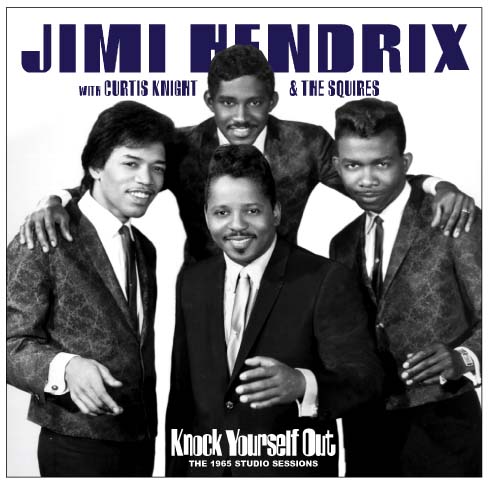 Jimi Hendrix with Curtis Knight - ‘Knock Yourself Out’
Jimi Hendrix with Curtis Knight - ‘Knock Yourself Out’
Notes by John Perry.
Today, it's almost impossible to imagine the impact that Jimi Hendrix made when he first appeared in England. The sounds he created have been copied so extensively they’ve become an accepted part of the musical landscape and more or less taken for granted -- few people can remember a time when they weren't there.
Hendrix’s licks have been imitated, sampled, and endlessly recycled but never, as yet, improved upon. Nor are they likely to be unless somebody, born with the same natural skills, gets a chance to sharpen them playing R&B rhythm guitar on some C21st equivalent of the chitlin circuit. The roots of everything Hendrix went on to do with the Experience lie either in the discipline and timing he acquired touring and recording with bands such as the Isley Brothers, Little Richard, and the Kingpins (King Curtis’s combo, which included Cornell Dupree on guitar and Bernard Purdie on drums) or in his reaction against that discipline and timing.
But there was a time when both the man and the sound of his guitar were unknown. Hendrix was a natural star of such magnitude that those days didn't last long, although anyone lucky enough to see him play during that brief period before he became the Most Famous Guitarist in the World is unlikely to forget it.
Hendrix’s rise is usually dated from September 1966, when Chas Chandler brought him to England, but the natural stages by which his playing developed don’t fall quite as neatly into line. It’s clear from the descriptions of fellow American musicians like Mike Bloomfield and John Hammond that everything was already in place by Jimi’s last six months in Greenwich Village, where he worked under the name of Jimmy James & The Blue Flames. Mike Bloomfield was guitarist with the Paul Butterfield Blues Band and a session-player on various Dylan recordings including ‘Highway 61 Revisited’ and Like A Rolling Stone. He considered himself to be the top US guitar player, bar none, until he heard Hendrix.
Mike Bloomfield. I was the hot-shot guitarist on the block. I thought I was it. I’d never heard of Hendrix. Then someone said, ‘You gotta see the guitar player with John Hammond’. I went straight across the street and saw him. Hendrix knew who I was and that day, in front of me eyes, he burned me to death. I didn’t even get my guitar out. H-bombs were going off, guided missiles were flying – I can’t tell you the sounds he was getting out his instrument. He was getting every sound I was ever to hear him get, right there in that room with a Stratocaster, a (Fender) Twin, a Maestro fuzztone and that was all. He just got right up in my face and I didn’t want to pick up a guitar for the next year.
Hendrix arrived in England in September 1966, and started playing shows the following month. By December he was gigging regularly and between January and March 1967 the Experience played about 20 club dates per month. By April ’67, the second single Purple Haze was in the charts and Hendrix had moved on from small clubs into theatres. Bashing round the country on the bill of a (singularly ill-matched) package-tour, Hendrix was well on the way to becoming public property. The secret was out of the bag: he was a major star in waiting, about to be unleashed before the world at the Monterey festival in June.
Apart from the pleasure of being in on the secret, there was something very special about those early shows, when you could stand a few feet away and watch Jimi playing to a couple of hundred club-goers. Combining the last months in America and the early days in England, it looks as though this final stage in his apprenticeship ran from around April 1966 till the end of March 1967. His skills were all in place but his fame had not yet grown so large that it came between you and what you were seeing.
When I saw him first, in February ’67, he wasn’t really known outside London. I’d heard Hey Joe on the radio -- and that was it. I had no expectations, no preconceptions. A school friend asked if I wanted to “go down the Locarno and see this American guitarist who plays with his teeth.” I said no -- but I went anyway.
The set contained only a few originals: Stone Free, Foxy Lady, Can You See Me and a song you might not expect so early, Third Stone from the Sun. These were mixed in with the material he’d been playing back in Greenwich Village at The Café Wha? -- Hey Joe (a cowboy song that Jimi made his own) straightforward covers of Rock Me Baby, Wild Thing and even the odd soul standard like Midnight Hour.
The best thing about these shows was the amount of fun Hendrix had playing them. He could handle the material in his sleep. He knew he could murder any guitarist in England. The lack of pressure, and the sense that something big was just about to happen for him produced ideal conditions to take risks, to kick the material out of shape and -- in a big word of the day -- 'loon' around with it. I saw Hendrix half a dozen times after he became a big star but I never saw him so completely carefree, or having such fun.
At the other end of the spectrum was the miserable Isle of Wight show in the summer of 1970, just a couple of weeks before he died. Hendrix was such an open, unprotected performer you always got a sense of how he was feeling on any given night from the sound he produced. That may sound like a fundamental requirement of any performer but believe me, it isn't. Only the very best are capable of eliminating the barrier between themselves and their performance, and of them, only a few are willing to go out into the ring without the safety of a rehearsed, pre-planned show. And that’s just as well: few performers are interesting enough to hold your attention for an hour with little more than extemporization.
At the Isle of Wight everything was wrong. Hendrix’s tone sounded edgy and brittle: his timing, usually so tight you never thought about it, was off. But the surest sign that something was wrong could be heard in his feedback. Instead of the usual rich, harmonically-pleasing notes an octave or an octave-and-a-half above the played note, his amps were producing discordant shrieks at random pitches -- more like a microphone feeding-back than a guitar. At most other times, Hendrix's use and control of feedback was supremely musical. He used discord and atonality but he never let them use him. At the Isle of Wight however, it slipped away from him -- and worse, you could feel it slipping away. Staying up four nights on Methedrine can really ruin your timing.
* * *
Hendrix had fairly relaxed ideas about contractual law -- though that was nothing new. In the musicbiz of the 50’s and early-60’s, songwriters would traditionally sell a song to 3 or 4 different publishers on the same day if they thought they had a winner. The trick was to get it sold quick. In the days when he had nothing to lose, Jimi treated contracts more like receipts than binding agreements. If somebody offered you $20 for a signature, you signed. Course you did. And signed an identical document promising everything to someone else the next day, if they offered money, too.
One such contract was offered by producer Ed Chalpin, whom Hendrix met through a Kansas-born singer/guitarist named Curtis Knight. Hendrix spent the summer of 1965 scuffling for gigs and sessions around New York and bumped into Curtis Knight at a time when he was short of a guitar. (Jimi was always losing or pawning instruments.) Knight saw Hendrix’s potential, lent him a guitar and immediately added him to his band, The Squires, who played regular dates around the bars and clubs of New York and Jersey. Curtis Knight was ambitious. A better hustler than he was singer, he figured that the new guitarist would also make an impression in the studio, so he approached Ed Chalpin who ran Studio 76, on Broadway and 51st.
Chalpin quickly spotted Hendrix’s potential and signed him up to his production company, PPX. This agreement contracted Hendrix to produce and play exclusively for PPX for 3 years, in return for one dollar. Chalpin seems to have seen this as a pretty good break for the young Jimmy Hendrix …
Ed Chalpin: "In almost 40 years of my career as a producer and manager I have, at most, taken eight acts under contract. They had to be something special. One of them was Jimmy Hendrix. Jimmy was to sing play and arrange for me exclusively. The contract was signed in the Hotel America on the night of 15th October 1965. At that time it was usual to insert the clause ‘For one dollar and other good and valuable consideration’ in contracts."
Tracks 1-10 of this album come from two studio sessions in late 1965, recorded soon after Jimmy signed to Chalpin. They’re mostly originals, written by Curtis Knight or other players on the sessions -- though some originals are more ‘original’ than others, as you’ll see when you play the ‘protest’ song, How Would You Feel. Hendrix’s guitar line shows that he was familiar with Mike Bloomfield’s work on Like A Rolling Stone.
Both How Would You Feel b/w Welcome Home and Hornets Nest b/w Knock Yourself Out were released as US singles in early 1966; the former was an attempt to crack the topical protest market, while Welcome Home bears more than a trace of Marvin Gaye's Can I Get A Witness.
Knock Yourself Out is a solid instrumental built over the same chord progression as Lee Dorsey's Get Out My Life Woman, and owes something to the sort of guitar showcase written by Earl King or Freddy King. If the Experience had ever organized the much talked-about session with Keith Emerson, it might have sounded like this. Hendrix’s guitar playing is tasty. He starts off in Booker T territory but moves along briskly: Steve Cropper never played that many notes. The ease with which Hendrix mixes set pieces from the instrumental blues guitar repertoire with stunts borrowed from surf-instrumentals makes it easy to understand why Third Stone From The Sun was one of his earliest compositions for the Experience.
Guitar players, and serious Hendrix enthusiasts will be interested in the rhythm guitar parts. We all know Jimi's lead lines backwards, but the key to his musical personality – and the reason he was such an effective songwriter -- is his strength as an accompanying guitarist. Where most guitarists are chiefly concerned with laying decorative lines on top of a song, Hendrix’s thinking is structural: his guitar parts work away inside a song, creating countermelodies and gospel-styled call and responses. Gotta Have A New Dress is a case in point. The solo is more or less what one would expect from 1965 Jimi, but the intro, and the guitar responses to the title line are a model of crisp R&B phrasing: tight, compact and melodic.
So here’s the 22 year-old Jimi Hendrix, working his first sessions as a ‘signed’ musician and arranger. Play the album and marvel at how much guitar-player you could get for $1 in the New York City of 1965!
John Perry © 2000
John Perry is a guitarist and author.
He formed the Only Ones with Peter Perrett and has recently published 2 books for Simon & Schuster, “Meaty Beaty Big & Bouncy - The Who’s Singles” and “Exile on Main Street.
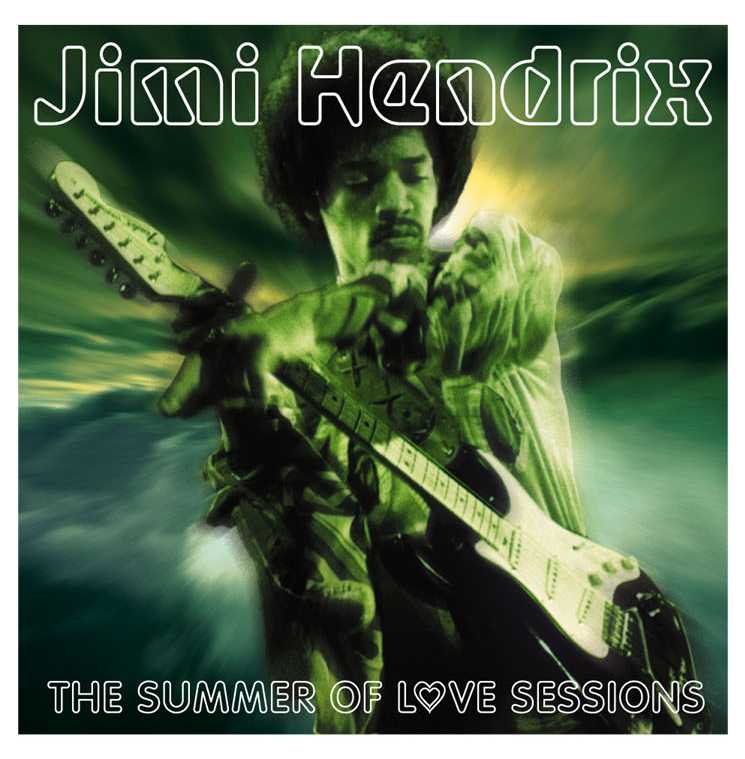 Jimi Hendrix - The Summer Of Love Sessions
Jimi Hendrix - The Summer Of Love Sessions
CD notes by John Perry
Jimi Hendrix left New York in September 1966 a complete unknown. When he returned to the city the following summer he was a star; the hottest new guitar player on the planet.
What happened in between says as much about the nature of hype as any radical development in Hendrix's playing, but consider it for a moment in personal terms. Six or seven years grafting, dragging round the South on R&B tours, slogging away in bars and clubs getting nowhere much at all – then, in as many months, you're right at the top. Press gone crazy. First album roaring up the charts. Big stars queuing up to jam with you. How would it feel, returning to your own country and your adopted hometown? What would be your first inclination? You'd probably seek out the musicians you'd worked with, spread a little hospitality round, play awhile, drink some and share some of your amazing good fortune.
That's what Hendrix did – and in a New York studio, someone left the tape rolling…
* * *
When it happened, it happened fast. Hendrix arrived in London known only to a few fellow musicians; English rockers who'd seen him in Greenwich Village clubs, and chitlin circuit veterans like Little Richard and The Isleys, who'd employed him as a rhythm guitarist. A couple of months working out of London changed all that.
In May '67 the first album Are You Experienced was released, and in early June Hendrix returned home to play his first American show, at the Monterey Pop festival. The reaction was immediate. Bill Graham booked the Experience for
five nights at the Fillmore. From the West Coast the word of mouth spread across the country.
Hendrix's management decided it’d be a good idea to book the band onto a US package tour featuring The Monkees. The idea wasn’t quite as far-fetched as it sounds. In Britain, Hendrix had already done similar tours with The Walker Brothers, Cat Stevens and Engelbert Humperdinck but by mid-1967 the scene was changing. America was changing. Monterey marks the moment when the Underground came overground, a separate subculture with its own venues, radio stations and record-buying habits. What had worked in wintertime England was already out of date in the American Summer of Love.
After a few dates with the Monkees, Hendrix wanted off the tour. Experience PR man Michael Goldstein invented a yarn. Why not claim The Daughters of The American Revolution (that singularly un-revolutionary mixture of Women's Institute and John Birch Society) had protested that Hendrix and his lewd jungle rhythms were corrupting the virginal minds of sensitive American children? Get him offa the tour!
The Experience quit after a show at Forest Hills and headed straight for more appropriate and congenial surroundings in New York clubland. The fortnight they spent hanging out in the clubs was their first break from non-stop gigging since January.
Away from the Experience, Hendrix went into Ed Chalpin's Studio 76 with his old partner, Curtis Knight. From these sessions came the tracks on this album, The Summer of Love Sessions. (Curtis Knight and Hendrix can be heard together on the CD's Driving South and Knock Yourself Out FREUD CD 065 and FREUD CD 066 – rarities now, as they're out of print.)
.
The album offers an opportunity to check out Hendrix's bass playing, which goes uncredited on Experience tracks like All Along The Watchtower (on much of Electric Ladyland in fact). But there’s no doubt here. Tracks 8-14 all feature Jimi on bass, most probably played upside down on a right-handed bass, too. It's clear he was listening to kind of parts Jamie Jamerson was playing on contemporary Tamla records, long fluid lines dodging around the melody instead of simply following the chords.
Alongside the single The Burning of The Midnight Lamp / The Stars That Play with Laughing Sams Dice these are some of the very earliest recordings of Hendrix using a wah-wah pedal. You can tell he’s enchanted by the hammering he gives it! As you might expect, he takes very little time to master the device. Straight away he’s able to get a range of expression out of an effect whose limits, at least in the hands (and feet) of most players, are pretty clearly circumscribed. On cuts such as the instrumental Level he’s tasteful in the extreme, whilst on others (Love Love for example) he goes wah-crazy!
The album opens with an eight-minute instrumental Love which features bags of ‘scratch-wah’; that’s deadening the strings with left hand (or in Hendrix’s case the right) so that no actual note is voiced, then scrubbing across them with the pick. With the wah-wah pedal added, it’s possible to articulate some pretty speechlike sounds – or if that’s too much effort, you can always produce the regulation Ike Hayes superbad sex machine-gun Shaft effect. Damn!!!
Hush Now is built round one of the stronger riffs on the album and contains some sweetly phrased lead guitar. It’s instructive to compare it with the instrumental Level…
The Curtis Knight song Gloomy Monday – a celebration of “the weekend” – is a fairly standard funk-ballad arrangement with a typical Hendrix guitar figure at the intro. The bridge is a surprise though. From the ‘Get Out My Life Woman’ feel of the verse, the song suddenly veers into waltz-time; one of those merry-go-round 3/4 devices which often seemed such a good idea to early psychedelic songwriters.
Also in compound time is the Ballad of Jimi. The writing credits are compounded too, sometimes accrediting Curtis Knight, sometimes Ed Dantes. Knight seems the more likely writer of a song that went through a number of versions between 1965 and 1970. A lilting requiem for Jimi Hendrix in 6/8 time, there’s nothing especially novel about the sentiments – “a song dedicated to the memory of my best friend” – except that this particular best friend wasn’t dead! Hendrix wasn’t to die for another three years.
Now Jimi's gone, he's not alone.
His memory still lives on.
Five years, this he said,
He's not gone, he's just dead.
Me and my best friend, Me and my best friend
Maybe it appealed to Jimi’s sense of humour? His closing chord is a portentous, doomy chord suspension sustained under the final line, which wrings maximum melodrama out the word ‘dead’. More likely though, this version of the vocal was dubbed over the 1967 track, new lyrics and all, after Hendrix’s death in September 1970 to facilitate a quick single release while the news was still hot (and the corpse still warm).
Get That Feeling is a straightforward soul/rave workout with namechecks for the soul hall of fame, James Brown, Wilson Pickett, Aretha, and helpful dance instructions too – “Two steps up/You gotta repeat.” Daytripper is the Beatles standard reworked with Jimi playing a funked up bassline on a Hagstrom 8 string bass. It’s funkier both than the original and the Hendrix version found on the BBC Peel Sessions. Check for yourself: here they are – Jimi Hendrix and The Summer of Love Sessions.
John Perry
John Perry is a guitarist and author.
He formed the Only Ones with Peter Perrett and has recently published 2 books for Simon & Schuster, “Meaty Beaty Big & Bouncy - The Who’s Singles” and “Exile on Main Street”, and also a pocket-sized book on 'Electric Ladyland'.
A brief history of The Slits
It’s difficult to describe the impact the The Slits had on the music scene twenty years ago, as now it’s difficult to imagine a pre-punk world with few female artists…
They came out of the heart of London’s punk scene: Viv Albertine and Palmolive were members of Flowers Of Romance along with Sid Vicious and Keith Levine, rehearsing in Joe Strummer’s squat. Meanwhile an all-girl group were rehearsing as The Castrators, including Kate Korus and Tessa Pollitt. Palmolive then teamed up with 14-year old Ari, the wildly brattish, precocious daughter of a former rock chick, German heiress Nora. Kate Korus joined The Slits as guitarist, before moving on to form The Modettes. Tessa and Viv then joined the ranks, completing the definitive early line-up.
After a few gigs they were invited by the Clash to support them on the ‘White Riot’ tour. The band quickly acquired a violent, chaotic image, attacking bands like Sore Throat and Throbbing Gristle on stage, and chosen by Derek Jarman to trash cars in his 1977 film ‘Jubilee’. Their music fitted the image - shambolic and loud, with abrasive guitar, shouted choruses, and crazy Ari’s screeched vocals over Palmolive’s hammered, stuttering drums.
Their uncompromising attitude, combined with gleefully subverting any and every notion of traditional female behaviour - skirts raised over heads, obscene and aggressive gestures, indeed anything to put the shits up people - scared the A&R men away. Peel Sessions in ’77 and ’78 was all the public got to hear, apart from gigs, which included tours with the Buzzcocks and Rich Kids. Other punk bands who’d taken their time - Siouxsie & The Banshees, Adam & The Ants - eventually got signed in 1978, but not the unpredictable, unmanageable Slits.
Record companies telling them they ‘weren’t tight enough’ led them to part company with Palmolive and her trademark drum style. Her replacement was Budgie from seminal Liverpool group Big In Japan (later a Banshee and Creature). But by the time of their long-awaited debut album ‘Cut’ on Island in 1979, they had become bored with punk. They embraced reggae, working with producer Dennis Bovell, who pared down their songs and gave them a dubby mix. The sleeve, showing them proudly and defiantly naked and covered in mud, guaranteed them attention.
Budgie was replaced by Bruce Smith of The Pop Group, with which group grew an association with both a shared single and managers Christine Robertson and Dick O’Dell. In 1980 indie singles ‘In The Beginning There Was Rhythm’, ‘Man Next Door’ and ‘Animal Space’ followed. Musicianship became more of a priority, with Steve Beresford accompanying them, and a more experimental, world music spirit permeated their work. Then a new contract with CBS produced the ‘Return Of The Giant Slits’ album in October 1981. Two months later, they held their final gig at Hammersmith Palais, announcing that they had no more plans as a group.
Although not commercially successful, The Slits are often cited as trail-blazing a path where others - from Riot Grrrls to perhaps Madonna and Spice Girls - could later tread.
Jungle release: 'In The Beginning' a live anthology. FREUDCD057
London Cowboys - biography
'Relapse' 2xCD
feat. Steve Dior & Barry Jones, with Jerry Nolan, Glen Matlock, Terry Chimes, Tony James, Mike Monroe, Arthur Kane, Sylvain Sylvain, Johnny Thunders and others.
The London Cowboys issue a double-CD: one disc being the highlights of their releases, the other comprised of unreleased material. In both categories there are bonus tracks from The Idols.
The London Cowboys were based around Steve Dior & Barry Jones who in 1976 were an integral part of London’s fledgling punk scene. They had loosely rehearsed with Chrissie Hynde and Keith Levene and others until Barry started co-promoting the first 100 days of The Roxy Club, booking the bands and designing the flyers. His teenage pal Steve came down to see the Heartbreakers on a pre-opening gig and fell in with the band. When Jerry Nolan left the Heartbreakers in August ’77, he formed The Idols with Steve and Barry; they soon moved to New York where Arthur Kane completed the line-up.
The Idols recorded demos for Track Records in London and made waves in New York, releasing a single on Ork Records. When Sid Vicious came to NY, they were his first choice of backup band (documented in recordings and Steve’s notes in ‘Sid Lives’, FREUDCD095), but the planned recordings with Sid never got to happen. The Idols folded in 1979 when Jerry had work-permit problems getting back into the UK. Barry then got a job with Max’s Kansas City; Steve rehearsed with the Sex Pistols' Steve Jones & Paul Cook’s new band, The Professionals.
The London Cowboys first incarnation was in the early 80’s, Steve together with the Sex Pistols’ Glen Matlock and singer Russell King, who issued a couple of successful singles in France. But when it came to an album, Steve fell out with King and brought back Jones and Nolan who both had returned to the UK, and took over vocals himself. The band continued for many years with Dior & Jones as the nucleus, with the Matlock/Nolan rhythm section substituted according to availability – Tony James, Pete Farndon and Terry Chimes amongst others filled those positions.
Later in the 80’s, the Cowboys’ brand of rock’n’roll found favour with record executives – Dolls-influenced bands had proved their dollar worth in the form of Guns & Roses and Billy Idol. MCA signed the London Cowboys with big plans that never materialised; then Chrysalis courted them. But no releases came out of that period, until now!
In late ’86 Jerry Nolan, Barry Jones and Glen Matlock teamed up again together with Johnny Thunders, for a tour of the world through 1987. Johnny had earlier guested on a unreleased Cowboys session; after he died Steve teamed up with Sylvain Sylvain for a tribute song – both included here. Steve & Barry must be the only musicians who’ve played with both four members of the New York Dolls and four members of the Sex Pistols!
Barry now lives in LA. Steve Dior took a break from music for a while but is back with a new band, The Delinquents.
www.myspace.com/londoncowboys
www.centralelements.com/barryjones
www.myspace.com/5delinquents
FREUDCD094 Release date: September 3rd 2008 Info: Alan Hauser.
A - Z Artists
Past & present - including:
54 Nude Honeys 999
A Popular History Of Signs Actifed Action Pact Actress Adicts Alex Ferguson Altered Images Alternative TV Andi Sexgang Anne Marie Hurst Art Attacks
Barbara Marsh Beasts In Cages Bebe Buell Bernie Torme Big Hair Bone Orchard Boyd & Wain Broken Bones Buddy Curtess
Carlene Carter Cellophane Chelsea Christian Death Class War Conflict Creaming Jesus Cuddly Toys
Dark Deacon Blue Dean Wareham Del Amitri Dogs Ducks Deluxe Dumb Blondes
Eddie & The Hot Rods Eden House Enemy
Fallen Angels Family Fodder Fields Of The Nephilim Flamin Groovies Flying Padovanis Foetus Corruptus Four Kings Freddy Lynxx & The Jet Boys
Gang War Geraint Watkins Goat Graham Parker Guitar Wolf Gun
Hawkwind Hank Wangford Heartbreakers Heroes Hillbilly Moon Explosion
Icons Of Filth Iggy & The Stooges Iggy Pop with Ministry Iggy Pop Igloos In Excelsis Inner Terrestrials
Jerry Nolan Jih Jimi Hendrix Johnny Nicky Johnny Thunders & Patti Palladin Johnny Thunders & The Heartbreakers Johnny Thunders & Wayne Kramer Johnny Thunders
Kim Fowley King Kurt Knights Of The Occasional Table
Lines London Cowboys Love & Money
Manufactured Romance March Violets Martin Belmont Material MC5 Menace Mercury Rev Metrophase Mr. Night & Mr. Day Mutton Gun
Neurotics New York Dolls Newtown Neurotics NFD Nick Lowe Nico Nina Simone Only Ones
Paul Carrack Peter & The Test-Tube Babies Play Dead Primal Scream
Rabid Racine Radial Spangle Raped Reg Meuross Rockin Rebels Romeo Street Gang Rubella Ballet
Sean Tyla Second Layer Senders Sexbeat Showgirls Sid Vicious Sigue Sigue Sputnik Sky Saxon & The Seeds Sky Sunlight Saxon Slits Specimen Sten Sterling Roswell Sylvain Sylvain
Terry Hooley Test Dept Texas Thee Michelle Gun Elephant They Must Be Russians Throbbing Gristle Toxic Waste Trojans Turkey Bones & The Wild Dogs Tyla Gang
Ubik UK Subs Urban Dogs
Varukers V-Human
Waldos Wall Wasted Youth Webcore Wendy James Wilko Johnson
Yobs
